This Frequently Asked Questions (FAQ) page will provide answers to questions we commonly get from property owners. Click on the links below to see the questions and answers pertaining to those specific topics. Please contact us at info@planning.lacounty.gov or 213-974-6461 if you require further clarification after viewing the FAQs.
Applicability and Exemptions
Any activity that meets the definition of development is subject to the SEA Ordinance. See the Zoning Code for the complete definition of “Development”. Scroll down to “Significant Ecological Areas” and locate Definition K.
The area of disturbance for development, both temporary and permanent, including, but not limited to, all structures, driveways and access, fuel modification areas, or direct habitat disturbances associated with the development. See the Zoning Code for the complete definition of “Development Footprint”. Scroll down to “Significant Ecological Areas” and locate Definition L.
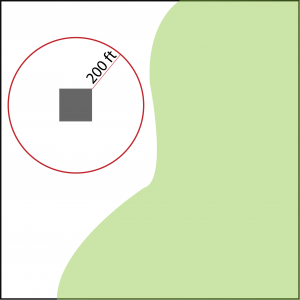
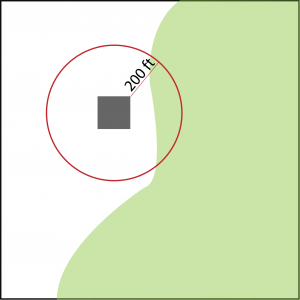
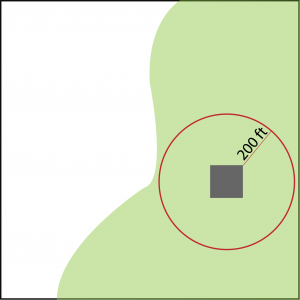
Only certain projects or activities are exempt from the SEA Ordinance. See the Zoning Code for the complete list of Exemptions.
If you are proposing a new single-family home within the Antelope Valley Area Plan boundaries, your home and associated development are exempt from the SEA Ordinance, except within the Three Points-Liebre Mountain Community Standards District.
If your new home is located elsewhere in LA County or Three Points-Liebre Mountain Community Standards District, it will be subject to the SEA Ordinance. However, if you are modifying an existing single-family home, your minor modifications may be exempt from the SEA Ordinance.
See the Zoning Code for the Exemptions A and B for the exemptions for single-family residences.
Yes, you will need to get prior approval for any vegetation removal if your property is within a SEA. Vegetation removal is considered development under the SEA Ordinance. See the Zoning Code for the complete definition of “Development”. Scroll down to “Significant Ecological Areas” and locate Definition K.
Only annual brush clearance activities for an approved fuel modification zone is exempt from the SEA Ordinance. See the Zoning Code for the Exemption I for the brush clearance exemption.
SEA Counseling
SEA Counseling is a pre-application counseling meeting that occurs before the permit application is submitted. Ideally, the SEA Counseling meeting is held before the project design is finalized. The goal is to help the prospective applicant design a project with the least impacts to the SEA resources and potentially meet the requirements to receive a Ministerial SEA Review. A Ministerial SEA Review is a cheaper and faster review process for the applicant.
See our Fee Schedule for the cost of “Significant Ecological Areas Counseling”.
You will need to submit 1) SEA Counseling application, 2) Biological Constraints Map (BCM), and 3) Conceptual Project Design. You will be sent an invoice for the SEA Counseling fee after you submit your application package and your application is assigned to a planner.
See our Applications and Forms page for the application form and checklist. Scroll down to “Significant Ecological Areas Counseling”.
A BCM is a map of the project site that identifies all the SEA Resources on the property. Only those consultants listed in our SEATAC Certified Biologist List can prepare a BCM.
See Chapter 6 of the Implementation Guide for the required details and examples of BCMs.
See our SEATAC Certified Biologist List to search for a biological consultant who can prepare a BCM.
Once you submit your SEA Counseling application, please give our Department about 2 weeks to send you an invoice and conduct a preliminary review of the application package. A planner will be assigned to your project and will contact you to schedule a meeting.
Yes, One-Stop and SEA Counseling meetings can happen at the same time. Please consult your planner if you would like to combine both meetings.
The recommendation given at the end of the SEA Counseling meeting is not an approval. It is a recommendation based on the BCM and Conceptual Project Design submitted. The recommendation consists of which Use Permit and SEA review type you will need for the full permit application process. At the end of the SEA Counseling meeting, the planner will provide instructions for next steps and a recommendation form.
Ministerial SEA Review
Your project will need to meet all 3 requirements to receive a Ministerial SEA Review.
- Building Site Area cannot be more than 20,000 sq. ft.
- Meet all applicable SEA Development Standards
- Provide required Open Space Preservation on-site
See the Zoning Code for the section on Ministerial SEA Review requirements.
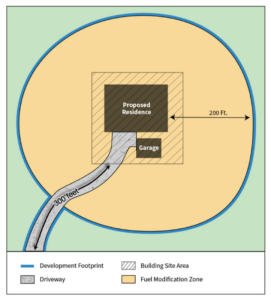 Building Site Area (BSA) is the portion of the development footprint that includes the building pad, graded slopes, structures, decks, patios, impervious surfaces, and parking areas. There are some development elements that are excluded from the 20,000 sq. ft. calculation for a BSA such as a portion of the driveway, fire dept required turn-around, graded slopes for access, and fuel modification zone.
Building Site Area (BSA) is the portion of the development footprint that includes the building pad, graded slopes, structures, decks, patios, impervious surfaces, and parking areas. There are some development elements that are excluded from the 20,000 sq. ft. calculation for a BSA such as a portion of the driveway, fire dept required turn-around, graded slopes for access, and fuel modification zone.
See the Zoning Code for the complete definition and requirements of “Building Site Area”. Scroll down to “Significant Ecological Areas” and locate Definition L.1.
No, a Ministerial SEA Review (MSR) is not a separate permit. It is a biological review conducted by the County Biologist that is tacked onto your Use Permit. The County Biologist will verify that the proposed project meets all the requirements for a MSR. A County Biologist Biological Review fee will be added to your Use Permit fee. The Use Permit is allows for the proposed use, MSR is only for impacts to the SEA Resources.
See our Fee Schedule for the cost of “County Biologist Biological Review”.
The length of time to get an approved Ministerial SEA Review (MSR) will depend on how long it will take to process your Use Permit. A MSR is not a separate permit. Please see the question above for more information on the MSR Process.
SEA Conditional Use Permit
Only those consultants listed in our SEATAC Certified Biologist List can prepare biological reports for SEA Conditional Use Permits.
See our SEATAC Certified Biologist List to search for a biological consultant who can prepare biological reports.
Typical biological reports required for a SEA CUP are the Biological Constraints Analysis (BCA) and Biota Report. See Chapter 6 of the Implementation Guide for the required details for a BCA and Biota Report.
Significant Ecological Areas Technical Advisory Committee (SEATAC) is a group of members from the private and public sectors with a range of expertise in ecology and habitat restoration. The members are appointed by the Planning Director. The committee meets the first Monday of each month to review developmental projects in SEAs. SEATAC aids the County in creating compromises that recognize the competing priorities of resource conservation, other critical needs of the public, and the development desire of private property owners. The Committee identifies significant biological resources and recommends necessary measures to support preservation, restoration, and enhancement that enable development compatible with the SEA resources.
See the SEATAC page for more information and Meeting Agendas.
Yes, if a SEA CUP is required for your project, both a SEATAC meeting and Public Hearing are required.
The average time for a SEA CUP to be scheduled for public hearing is 12-18 months. The time frame greatly depends on the quality and timeliness of information submitted by the applicant.
SEA Development Standards
The SEA Ordinance establishes Development Standards to ensure that development is designed in a manner that supports the long-term sustainability of each SEA. Projects must comply with all applicable Development Standards in order to obtain approval for a Ministerial SEA Review or request modification of Development Standards through a SEA Conditional Use Permit.
Please see the Zoning Code for a complete list of SEA Development Standards. You can also refer to Chapter 4 of the Implementation Guide for further explanation and guidance for each development standard.
No, you will be required to meet only the development standards that are applicable to your project. One of the requirements to receive a Ministerial SEA Review is to meet all applicable development standards.
SEA Resources are the biological and physical natural resources that contribute to and support the biodiversity of SEAs and the ecosystem services they provide. The SEA Ordinance divides SEA Resources into five categories, with each category afforded a certain level of protection consistent with its relative abundance in the County and sensitivity to disturbance.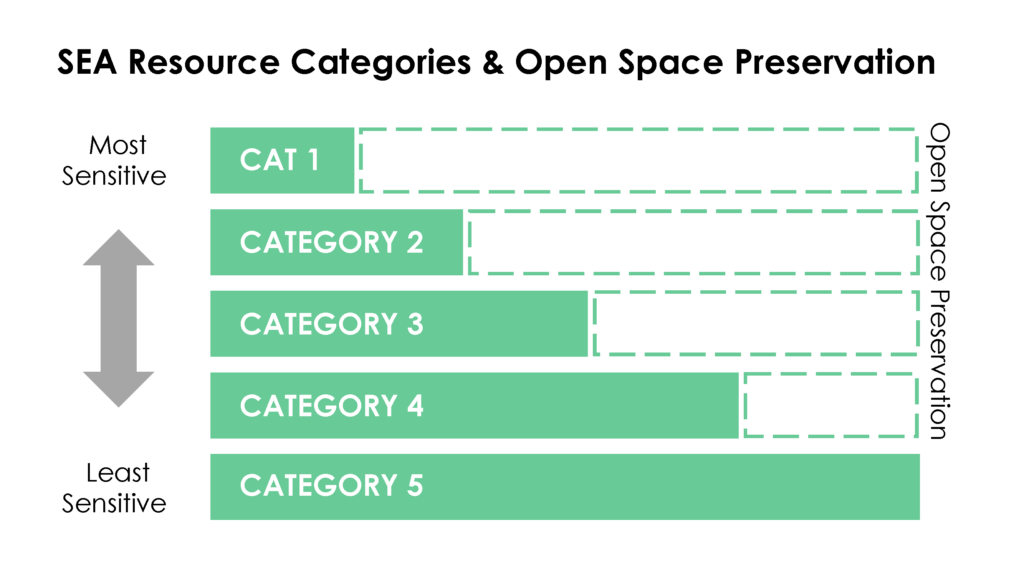
No, the SEA Resource categories are not mapped. The applicant is required to survey and depict the SEA Resource categories found on the property through the Biological Constraints Map (BCM). A BCM is a map of the project site that identifies all SEA Resources on the property. A BCM must be prepared by a qualified biologist on the SEATAC Certified Biologist List.
See Chapter 6 of the Implementation Guide for the required details and examples of a BCM.
See our SEATAC Certified Biologist List to search for a biological consultant who can prepare a BCM.
The 200 ft distance requirement correlates to the 200 ft fuel modification zone that is required by the Fire Department for structures in the Very High Fire Hazard Severity Zone. Typically, fuel modification zones can encroach onto neighboring properties. However, the Natural Open Space Buffer Development Standard prohibits that encroachment onto the neighboring property if it is a protected open space. Protected open space can be land owned by conservancies or private properties that were required to set aside open space easements to mitigate previous development.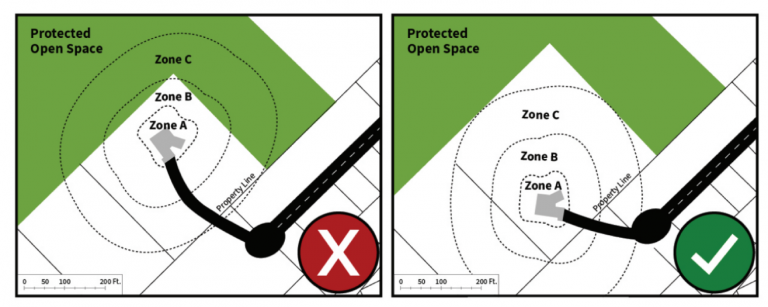
Protected Trees
The SEA Ordinance Update added 60 tree species to be protected in addition to already protected oak trees. The SEA Protected Tree List specifies the species of tree protected in each individual SEA and the size of the tree when regulations are applied.
Please see Appendix A of the Implementation Guide for the complete SEA Protected Tree List.
If you believe that an existing protected tree may endanger the safety of property or people, please contact the Los Angeles County Forester for the possibility of an Emergency Protected Tree Permit to remove the tree. The Forester may be contacted at (818) 890-5719. The Forester may indicate that an Emergency Protected Tree Permit cannot be issued after a visual inspection. In that case, the removal of the tree is subject to the SEA Ordinance.
Please see the Zoning Code for Exemption M for the Emergency Removal of a Protected Tree Exemption.
Tree maintenance, limited to removal of dead wood and pruning of branches not to exceed two inches in diameter and 25 percent of live foliage within a two-year period, intended to ensure the continued health of a SEA Protected Tree is exempt and do not require a permit. Any trimming exceeding this threshold or done for development purposes is subject to the SEA Ordinance and a permit/approval is required.
Please see the Zoning Code for Exemption N for the Tree Trimming Exemption.
Please see the Zoning Code for Protected Tree Permit requirements.
A Protected Tree Permit is required in the scenarios indicated in red below. A Protected Tree Permit is a Minor Conditional Use Permit, which requires a public hearing. Please see the Zoning Code for Protected Tree Permit requirements.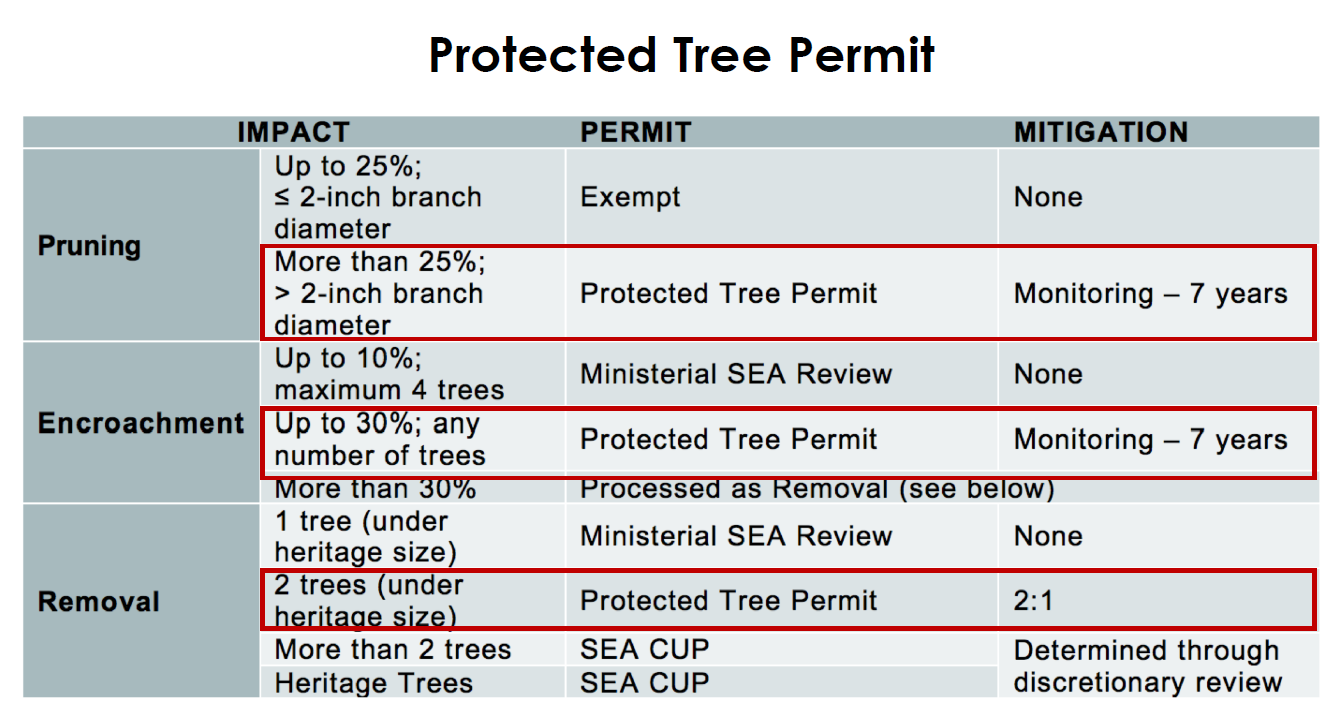
Enforcement
The first step would be to contact the zoning enforcement inspector listed on the Notice of Violation. Depending on the violation, temporary erosion control measures may be required while going through the SEA approval process to legalize the unpermitted use/activity. If the property owner chooses not to legalize the use/activity, then restoration of the habitat may be required.
See the Zoning Code for more information on Enforcement requirements.
The benefits of consulting with Regional Planning before starting any unpermitted activity is the time and costs savings. Often times, the unpermitted activity is too large-scaled that a SEA CUP is retroactively required, which takes a long time to process and is costly. Our Department’s goal is to help property owners to build a project that will have the least amount of impact to biological resources and provides a cost and time benefit to the applicant.
Please contact our Land Development Coordination Center is you would like more information before starting any vegetation removal, grading, or trucking in fill material. You can reach us at info@planning.lacounty.gov or 213-974-6461.

